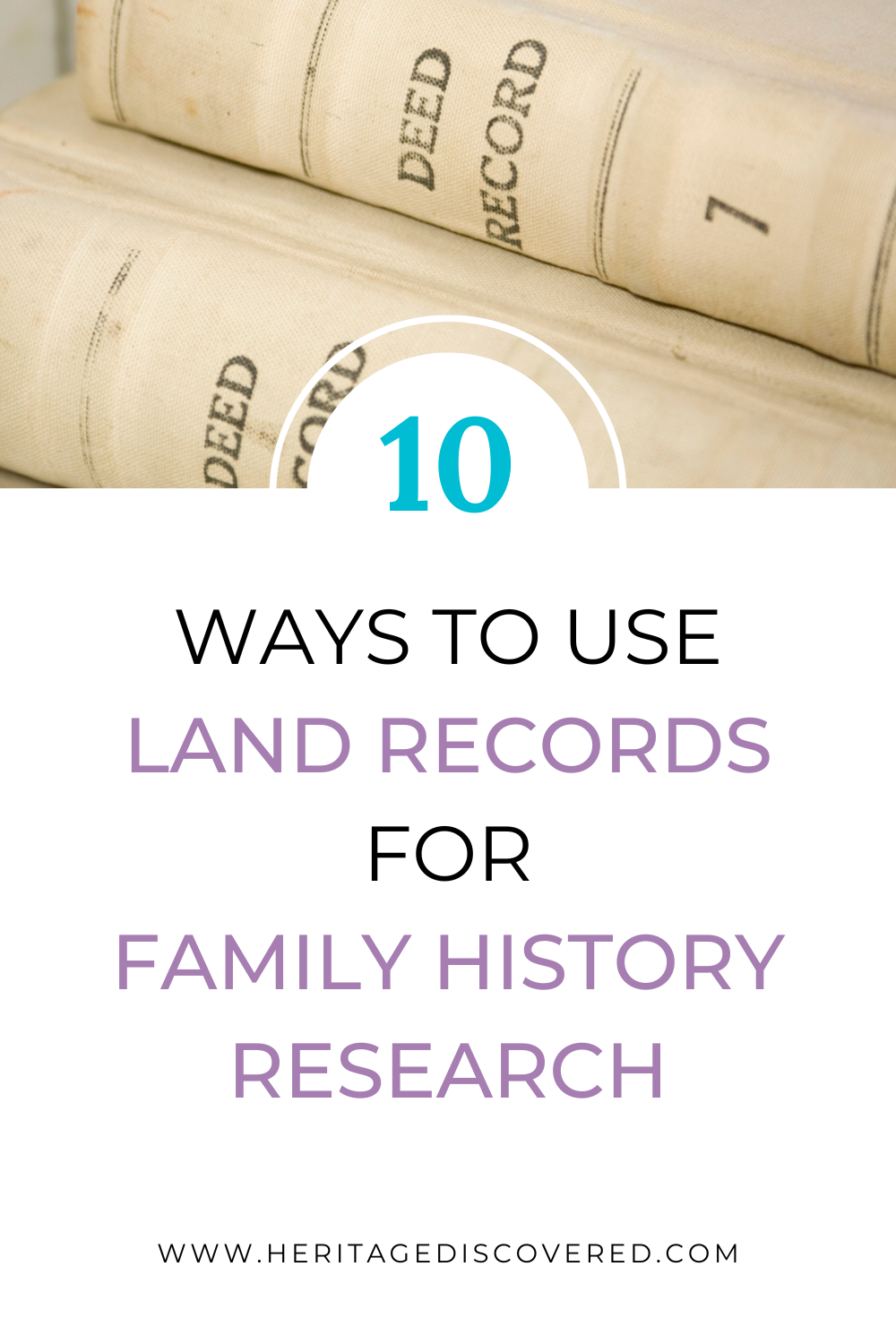10 Clues In Historical Land Records For Your Genealogy Research
*This post may have affiliate links, which means I may receive commissions if you choose to purchase through links I provide (at no extra cost to you). All opinions remain my own.
Are you using historical land records in your genealogy research?
Not going to lie, it took me a long time to add land records to my top resources to search for when researching someone.
I felt a little intimidated by them.
They are a little more complicated than other records. They’re full of legalese. They aren’t always online. They can be hard to read.
I felt censuses, vital records, and probate records were “sexier” and had more direct genealogical information in them.
Now, I can’t get enough of historic land records.
They are hands down one of the most underutilized types of genealogy records given how much you can learn from them.
There are many kinds of old land records you can use in your research, which I’ll leave for another article because it’s too big a topic to explore here.
This article focuses on the clues you can find in land deeds, one of the most common types of property records.
Why historical land records are important for genealogy
As I mentioned, real estate records are invaluable genealogy resources, but are often overlooked in favor of other types of records.
Here are some of the key reasons to seek out these records for your research:
Because they deal with property, these records are often very well preserved. In the event of a courthouse being destroyed, deeds were often re-registered or otherwise reconstructed to ensure proof of ownership.
The records extend back further than many other types of records, including federal censuses. This means they are one of the most complete records sets you may come across for a location.
Land records fix your ancestor in a specific place and time, including before the census began or between census enumerations.
90% of adult free males were landowners before 1850, so there is a good chance you can come across at least one deed for your male ancestors.
It’s one of the few types of genealogy documents that applies to many groups of people, no matter where or when they lived or where they were born. (There are some exceptions to immigrants owning land depending on the time, but for the most part these apply to broad groups of people.)
They can be useful in sorting out people that have the same name in the same area.
They can supplement other records like tax lists or probates to gather more details about your ancestor’s real estate.
These records can also tell you about the community your ancestor lived in.
Tools like a land records table will help you track all their property and record the clues in them. This can lead you to even more records, and answer questions like what your ancestor’s wife’s name was or her parents’ names.
Related posts:
How To Avoid A Brick Wall And Research Your Ancestors With Common Names
11 Smart Strategies For Searching For Ancestors Who Changed Their Name
How To Use Online Family Trees The Right Way
What is a deed?
At its core, a deed is a legal document that transfers title to real property from one party/parties to another. The deed describes the tract and records the names of the grantors (the person selling), and the grantees (the person buying).
Deeds are generally found at the county level at the local courthouse. Some states in New England, like Vermont, keep deeds at the town level.
There are several types of deeds, from warranty deeds to quitclaims to deeds of trust. But all will generally have:
the date of sale
name of the grantor and where they lived
name of the grantee and where they lived
the amount received for the property
description of the parcel
signature/mark of the grantor
signatures of the witnesses
And from this information, we can get clues for our family history research.
To understand the actual description of the tract in deeds, surveys took place in one of two ways: state land and public land.
State land states include the 13 colonies settled before the Revolution. Hawaii, Kentucky, Maine, Tennessee, Texas, West Virginia, and Vermont are also state land states.
These use the metes and bounds system based on local landmarks like fences, stones, roads, and trees. If you have a deed that says something like “11 rods to a stake and stones thence north on said highway 14 rods…,” that’s a metes and bounds deed.
Public land states are the other 30 states and are land originally owned by the federal government. These are surveyed on a grid system based on an east-west baseline (ranges) and a north-south meridian (townships).
Each square on the grid could then be broken down into smaller sections.
If you have a deed that says something like “The north 1/2 of the southwest quarter of the southwest quarter of section 18, township 25 north, range 15 east," that’s public land.
Related posts:
Solve Your Genealogy Brick Wall: Review and Analyze Your Research
Solve Your Genealogy Brick Wall: How To Evaluate Your Sources
Solve Your Genealogy Brick Wall: 10 Ways To Widen Your Research Net
Genealogy clues in historic land records
So, we talked about why land records are important for your family history research. Now let’s discuss what clues you can uncover in deeds.
1) Wife’s name. Deeds are one of the only pre-1850 records that can record a wife’s name.
2) Release of dower. Depending on the state and time, women had a right to one-third of their husband’s estate, as long as she lived or didn’t remarry. This means deeds can mention her name because she had a right to any property bought or sold.
A release of dower is releasing a wife’s claim to the real estate. This is a specific clause that can come after the deed saying that the wife has agreed to the sale, including giving up her dower rights.
The release of dower proves a marital relationship. Again, it may also be one of the only places a wife’s name appears.
3) Relationships between grantors and grantees. While not always as direct as probate records, deeds can name a person’s children or other relationships, such as siblings and parents.
For example, I’ve seen deeds with language like “Jonathan Merrill of Haverhill in the County of Essex and Commonwealth of Massachusetts…and David Merrill of Peacham in the County of Caledonia and State of Vermont…to William Merrill of Haverhill…land belonging to my hon’d Father deceased…”
While this example doesn’t conclusively prove a relationship, it does tie people with the same surname in different states together, indicating some sort of kinship. The mention of a father points to a possible close relationship like brothers.
Tracing that holding to the last purchase could tell you the father’s name. From there, other records could be sought to establish the exact relationships between everyone.
4) Other places of residence. People didn’t always buy and sell landholdings when they were living in that locality. Your ancestor could have been buying grounds in preparation to move or selling after they had left an area.
As deeds record where the grantors and grantees were living, this could give you a clue that your ancestor had moved.
For example, “John Brown of Chester in the County of Rockingham and State of New Hampshire…to Samuel Merrill of Londonderry in the County of Rockingham…land being in Chester.
I came across this 1808 deed while searching for my likely 6th great-grandfather, Samuel Merrill. Samuel disappeared from Londonderry by 1810.
Did he move to Chester? Was this an investment property?
I’m still researching this, but it’s potentially a reason why he stopped appearing in Londonderry records around this same time.
5) Dates of residence. Very few other records will tell you exactly when and where your ancestor lived in a specific place. While you may know the town or city they lived in and a general timeframe, deeds will tell you the exact dates they owned property somewhere.
6) Where the lot was. Whether the deed uses state land or federal land survey systems, it tells you where your ancestor’s holding was. You can then use plat maps and other tools to plot out the estate and compare it to modern-day maps to see where they lived, and even visit in person.
7) Signatures. If you are trying to figure out several men with the same name in the same place at the same time to see which is your ancestor, a signature can be a clue to separate each from the other. This, combined with other clues, like relationships or residences, can enable you to separate each person.
8) Their FAN club. If you haven’t heard this phrase before, it stands for Friends/Family, Neighbors, and Associates. Deeds contain the names of witnesses, who can be relatives, or at the very least trusted friends or associates.
Deeds also name neighbors, who could be relatives like in-laws. They could have also migrated together from another place, which could give you a clue where your family was from. Mapping out the community with this information can give you a sense of what it looked and felt like.
Researching collateral relatives and associates can give you answers about your ancestor.
9) Chain of title. Chain of title is the documentation tracing the ownership of a property from the current owner to the original owner. With this, you could uncover relatives that previously owned the parcel, including direct ancestors and in-laws. It can include specific details like relationships between parties.
10) Economic status. While deeds aren’t a comprehensive view of how wealthy your ancestor was, they can give some insight into their economic status based on how much acreage they owned and its value.
Related posts:
6 Common Genealogy Mistakes And How To Avoid Them
Finding the Parents of Sarah Merrill Part 1: a Genealogy Case Study
How To Solve Your Genealogy Brick Wall With Surname Research
Final thoughts
While US land records may be a little more complicated to use than birth certificates and censuses, they can give you just as many clues.
Moreover, they are one of the oldest and most complete types of genealogy records. If your ancestor lived somewhere before vital records or other resources were being kept, land records are one of your best bets to find mention of them.
They can provide many clues about your family that you may not come upon anywhere else, especially for earlier time periods. These clues may aid you in breaking your research brick walls.
Tools like a land records table will lend a hand in tracking all the real estate your ancestor bought and sold and record the clues in them. This can lead you to more records and get answers like the relationships between people.


